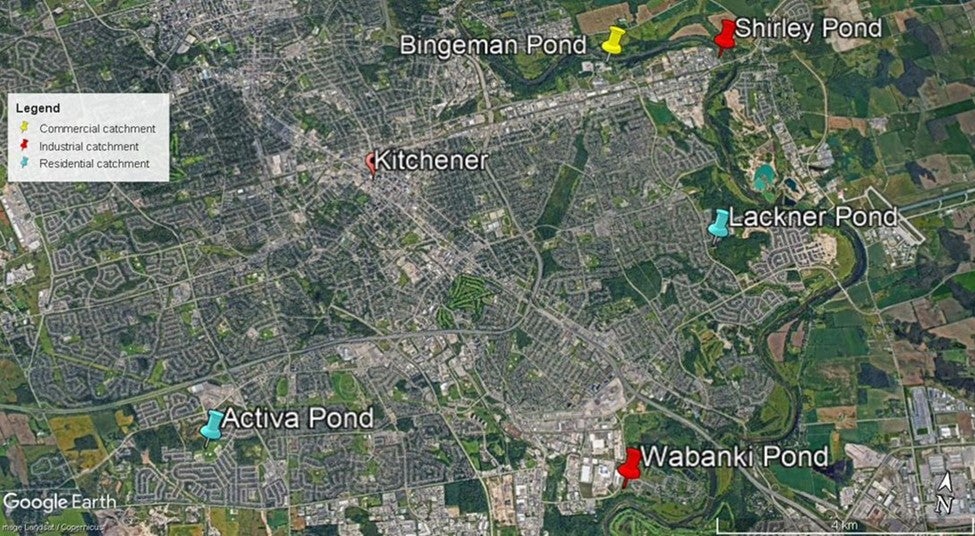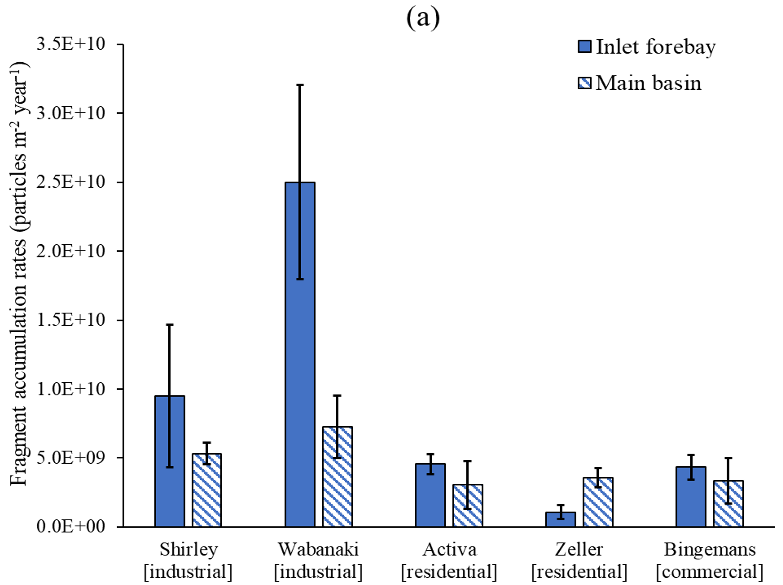Understanding microplastics in urban stormwater ponds: A step towards cleaner watersheds
By Hang Nguyen
Microplastics (MPs), tiny plastic particles less than 5 mm in diameter, pose a growing threat to both aquatic and terrestrial ecosystems due to their toxicity and resistance to degradation. In urban areas, stormwater runoff is a major conduit for MPs, often channeling them into green infrastructure such as stormwater ponds (SWPs). While existing evidence suggests that SWPs can effectively reduce MP loads from urban runoff, the mechanisms behind their retention and accumulation remain underexplored.
My Master’s research at the University of Waterloo focused on quantifying and characterizing MPs in stormwater ponds across the City of Kitchener, Ontario. My goal was to identify what factors influence their accumulation and distribution. By understanding this, we will be able to characterize MPs mobilization and their fate in the environment.

Map of five sampling sites within the City of Kitchener.
I began by collecting sediment and water samples from five SWPs that drain different types of land uses. I compared MP abundance, shapes, types, and sizes across the samples, while considering sediment properties, catchment characteristics, and environmental conditions.
The results were very interesting. Perhaps most importantly we discovered that MP accumulation varied across the five SWPs. Ponds that drain industrial land uses had MPs accumulation in the sediment levels two to three times higher than those with commercial or residential areas (Figure 1). Fragments were the dominant shape of MPs in the pond sediment, as their accumulation rates were substantially higher than fiber’s accumulation rates (Figure 1). We also found hotspot locations in the SWPs – MPs are most likely to settle in the inlet forebays, along with sediment and organic carbon. My results suggest that the land use that surrounds the SWP and sediment loading into SWPs are critical factors in MP accumulation and distribution.


Figure 1: This figure shows the number of microplastic fragments (a) and fibers (b) found in the five stormwater ponds across the City of Kitchener, Ontario.
Other interesting findings include:
- MPs abundance in the pond water fluctuated with significant seasonal variation throughout the year with the highest concentration recorded in a residential pond.
- Two types of plastic - Polyamide and polyethylene - accounted for the majority (~ 80%) of the plastic present in the pond sediment and water
- Most of the MPs were small, less than 50um, consisting of 85% of the particles recovered
- Precipitation, wind speed, and pond hydraulic loading were also found to wash away surface MPs and dilute MP concentration in the water column.
There are several implications for this research. First, it provides a foundation for further study on MP mass balance and budgets in urban areas. Second, MPs in SWPs can shed light on local sources of MP pollution – the abundance, shapes, types, and sizes that come from the surrounding catchment. This is an important step in identifying where MPs are coming from, which could be helpful in developing tailored management strategies to mitigate the impacts of MPs. Finally, may research demonstrates that SWPs are effective at capturing and retaining MPs.
To learn more, you can read Hang’s thesis here.